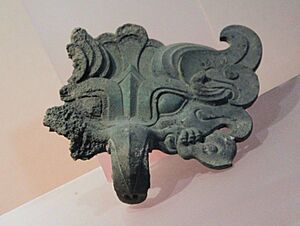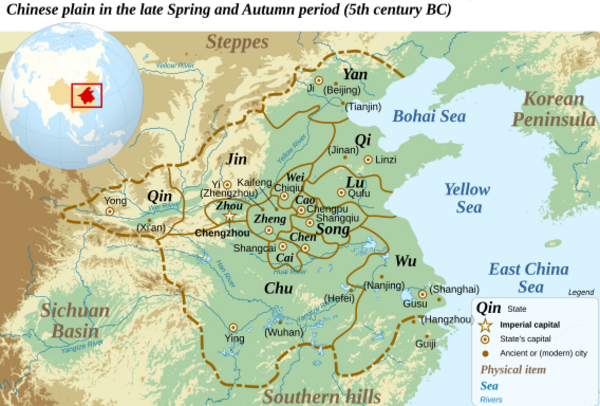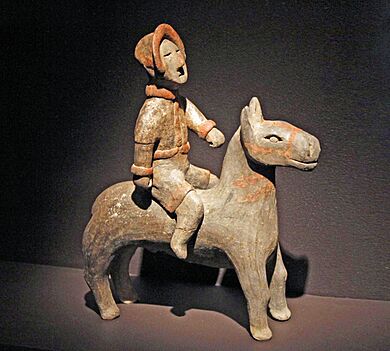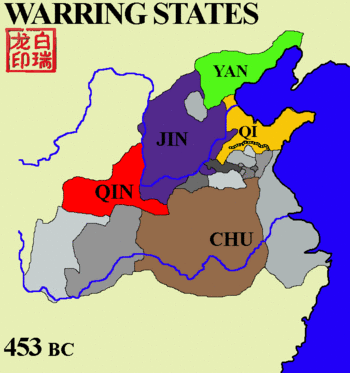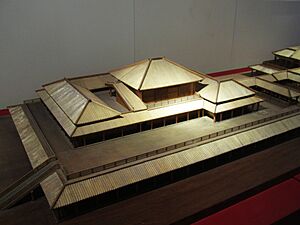Qin (state) facts for kids
Quick facts for kids
Qin
|
|||||||||||
|---|---|---|---|---|---|---|---|---|---|---|---|
| 9th century BC–207 BC | |||||||||||
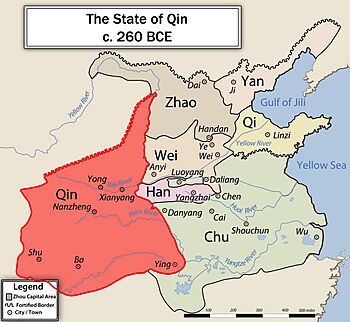 |
|||||||||||
| Capital |
|
||||||||||
| Common languages | Old Chinese | ||||||||||
| Religion |
|
||||||||||
| Government | Monarchy | ||||||||||
| History | |||||||||||
|
• Established
|
9th century BC | ||||||||||
|
• Founded by Feizi
|
860 BCE? | ||||||||||
|
• Declared empire
|
221 BC | ||||||||||
|
• defunct
|
207 BC | ||||||||||
| Currency | ancient Chinese coinage | ||||||||||
|
|||||||||||
| Today part of | China | ||||||||||
| Qin | |||||||||||||||||||||||||||||||||||
|---|---|---|---|---|---|---|---|---|---|---|---|---|---|---|---|---|---|---|---|---|---|---|---|---|---|---|---|---|---|---|---|---|---|---|---|

"Qin" in seal script (top) and regular script (bottom) characters
|
|||||||||||||||||||||||||||||||||||
| Chinese | 秦 | ||||||||||||||||||||||||||||||||||
|
|||||||||||||||||||||||||||||||||||
Qin (pronounced "Chin") was an important ancient Chinese state. It existed during the Zhou dynasty period. Qin started around 897 BC. It grew from lands in the west that had been taken over by the Xirong people. Being on the western edge of China helped Qin expand and develop in ways other states couldn't.
After many changes in the 4th century BC, Qin became one of the strongest states. It was one of the Seven Warring States that fought for control of China. In 221 BC, Qin united all these states under one ruler, Qin Shi Huang. This led to the start of the Qin dynasty. Even though this dynasty was short, it had a huge impact on China's future. The Qin state before this unification is sometimes called "predynastic Qin."
Contents
History of Qin
How Qin Began
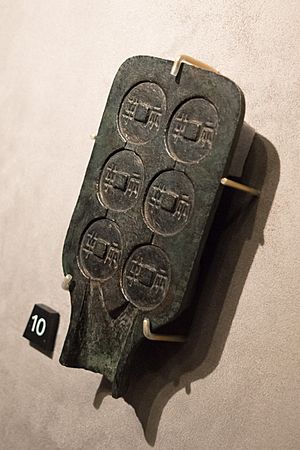
Ancient records say the Qin state came from a legendary emperor named Zhuanxu. One of his family members, Boyi, was given the family name Ying. Over time, the Ying family split into two groups. One group moved west to a place called Quanqiu. The other group settled east of the Yellow River. This eastern group became the ancestors of the rulers of the later state of Zhao.
The western Ying family lived in Quanqiu. They protected the Shang dynasty from attacks by the Xirong people. Later, during the Zhou dynasty, one of their leaders, Elai, died defending the Shang king. However, the Ying family was still allowed to keep their lands.
A man named Feizi, a descendant of Elai, was very good at breeding horses. King Xiao of Zhou was so impressed that he gave Feizi a new piece of land in the Qin valley. This area was named Qinyi. Both parts of the western Ying family lived among the Rong tribes. Sometimes they fought, and sometimes they even married into the Rong royal families.
Some historians think that because their ancestor was a horse breeder, the Ying family might have had some ties to nomadic tribes. Even later, people from other Chinese states thought Qin culture was a bit rough. This was because Qin was located on the edge of China and had mixed with northern and western tribes. But Qin leaders wanted to show they were truly Chinese.
Around 842 BC, nobles rebelled against the Zhou king. The Xirong tribes used this chance to attack. They destroyed the main branch of the Ying family at Quanqiu. This left Feizi's family at Qinyi as the only Ying clan left in the west.
When King Xuan of Zhou became king, he sent Qin Zhong, Feizi's great-grandson, to fight the Xirong. Qin Zhong died in battle, and his son, Duke Zhuang, took over. King Xuan gave Duke Zhuang and his brothers 7,000 soldiers. They defeated the Rong and got back their family lands. Duke Zhuang then moved his capital to Quanqiu.
When Duke Zhuang died in 778 BC, his second son, Duke Xiang, became the leader. In 777 BC, Duke Xiang tried to make peace by marrying his sister to a Rong leader. The next year, he moved the Qin capital east to Qian. But Quanqiu soon fell to the Rong again.
In 771 BC, the Zhou capital was attacked and the king was killed. Duke Xiang helped the new king, King Ping, move the capital to Luoyi. As a thank you, King Ping made Qin a major state with full independence. He also promised Qin all the lands west of Qishan if Qin could drive out the Rong tribes. This promise encouraged Qin rulers to fight the Rong and expand their territory. Qin saw itself as the rightful heir to the Zhou kings.
Spring and Autumn Period (722–481 BC)
During the Spring and Autumn period, Qin mostly focused on fighting the Rong tribes in the west. They didn't interact much with other Chinese states. The main exception was their neighbor to the east, Jin. Qin and Jin sometimes had good relations, even marrying into each other's royal families. But sometimes they fought.
When Duke Mu of Qin was young, Jin was very powerful. After Jin's ruler died, his sons fought for control. One son, Duke Hui, won. Later, in 647 BC, Jin had a famine and asked Qin for help. Duke Mu, whose wife was Duke Hui's half-sister, sent food and farm tools. But when Qin had a famine the next year, Duke Hui didn't help. This led to a war in 645 BC. Duke Hui was captured, but Duke Mu later released him. Jin then agreed to give up some land and become allies with Qin.
Duke Mu later helped another of Jin's exiled sons, Chong'er, become the ruler of Jin. This improved relations between Qin and Jin. With peace on his eastern border, Duke Mu focused on fighting the Rong tribes in the west.
In 627 BC, Duke Mu tried to secretly attack Zheng. But his army turned back after being tricked into thinking Zheng was ready for them. Jin, now led by Duke Xiang, ambushed the retreating Qin army. Qin suffered a big defeat. Three years later, Qin attacked Jin for revenge and won a major victory. Duke Mu then decided to focus on expanding Qin's power in the west. Because of his success in the west and his dealings with Jin, Duke Mu is considered one of the Five Hegemons of this period.
By 546 BC, Qin was seen as one of the four most powerful states in China, along with Jin, Chu, and Qi.
In 506 BC, the state of Wu defeated Chu and captured its capital. This was a great humiliation for Chu. A Chu official named Shen Baoxu went to the Qin court and begged Duke Ai of Qin for help. Duke Ai at first refused, but Shen cried in the palace courtyard for seven days. Duke Ai was so moved that he agreed to send troops. In 505 BC, Qin and Chu armies together defeated Wu. This allowed the Chu king to return to his capital.
Warring States Period (475–221 BC)
Early Years and Changes
In the early Warring States period, Qin's neighbors in central China were growing fast. The state of Wei, which formed after Jin split, became very strong on Qin's eastern border. Qin mostly relied on natural defenses like mountain passes to protect its heartland. Between 413 and 409 BC, the Wei army attacked Qin and took some Qin lands west of the Yellow River.
Legalist Reforms
In 362 BC, Qin defeated Wei and Han. After these wins, Qin rulers began making big changes to their laws, economy, and society. In 361 BC, Duke Xiao of Qin became ruler. He invited talented people from other states to come to Qin and help him with his reforms. He promised them important jobs and land.
One of these talented people was Shang Yang. He led a series of reforms in Qin, even though many old-fashioned politicians were against him. These reforms were based on a philosophy called Legalism. This meant that all common people were given rights as citizens. Many were moved to new areas to help increase farm production. People were promoted based on their skills and achievements, especially in the military. Soldiers and officers were rewarded for their efforts, no matter where they came from.
However, the laws were very strict. Even small mistakes led to harsh punishments, and nobles were not exempt. Over many years, these reforms made Qin strong both economically and militarily. Qin became a highly organized state with a very effective government.
After Duke Xiao died, King Huiwen of Qin became the new ruler. He had Shang Yang executed for treason. Some people thought the king held a grudge because Shang Yang's strict laws had punished him for a minor offense when he was young. Despite this, King Huiwen and the rulers after him kept Shang Yang's reforms. These reforms were the foundation for Qin's eventual unification of China in 221 BC. Shang Yang's ideas were later developed by another Legalist scholar, Han Fei. After these reforms, Qin became the most powerful state among the Seven Warring States.
Qin's Dominance
In 364 BC, Qin defeated the armies of Wei and Han. The Zhou king, who was the official ruler of China, declared Duke Xian the "Hegemon" (a powerful leader) of China. His successor, Duke Xiao, was also given this title. A hegemon was seen as a leader who controlled the military and trade of other states.
After Duke Xiao, Qin kings were not officially called Hegemons, but Qin remained the most powerful state until it conquered all of China in 221 BC. Qin rarely lost battles and defeated other states in at least 15 major campaigns. A Qin official named Li Si wrote in 246 BC that Qin had brought other states "into submission" through military victories. By the 240s BC, other states were already obeying Qin as if they were part of its own territory.
By the late 4th century BC, other Chinese states became worried about Qin's power. They started forming alliances against Qin. Qin often fought against these alliances. This continued for the last century of the Warring States period.
Qin's success was also due to its hardworking people. Qin kings started many large projects, including irrigation canals and defensive walls.
The reforms also greatly changed Qin's military. Before, the army was controlled by nobles. But after Shang Yang's reforms, the old noble system was removed. Ordinary citizens could now rise to high ranks in the military based on their skills. Military rules were very strict, and soldiers were trained to fight better in different situations. With the full support of the state, Qin's military became incredibly strong. In 318 BC, several states formed an alliance and attacked Qin, but they couldn't get past Qin's defenses and were defeated. The alliance fell apart because the states didn't trust each other.
Shang Yang's reforms also created more workers for public projects, like improving farming. This allowed Qin to support a huge army of over a million soldiers. No other state, except Chu, could match this. Qin also conquered the southern states of Ba and Shu (modern Sichuan). These new lands were very fertile and provided Qin with many supplies and more soldiers. It was hard for Qin's enemies to attack Ba and Shu because they were deep in the mountains. At the same time, Qin could use these lands to launch attacks on the state of Chu.
Actions Against Chu
| Year | Events |
|---|---|
| c. 557 BC | Qin fought with Jin |
| 361 BC | Duke Xiao became ruler of Qin |
| 356 BC | Shang Yang started his first reforms in Qin |
| 350 BC | Shang Yang started his second reforms in Qin |
| 338 BC | King Huiwen became ruler of Qin |
| 316 BC | Qin conquered Shu and Ba |
| 293 BC | Qin defeated Wei and Han at the Battle of Yique |
| 260 BC | Qin defeated Zhao at the Battle of Changping |
| 256 BC | Qin ended the Eastern Zhou dynasty |
| 247 BC | Ying Zheng became ruler of Qin |
| 230 BC | Qin conquered Han |
| 228 BC | Qin conquered Zhao |
| 225 BC | Qin conquered Wei |
| 223 BC | Qin conquered Chu |
| 222 BC | Qin conquered Yan, Dai, and the Wuyue region |
| 221 BC | Qin conquered Qi and united China under the Qin dynasty |
During the rule of King Huiwen of Qin, the state of Chu became a target for Qin. Chu had a very large army, but its government and military were weak due to corruption. The Qin strategist Zhang Yi suggested attacking Chu. Over the next few years, Zhang Yi used clever plans to break up Chu's alliances. Qin also launched constant military raids on Chu's border. Chu suffered many defeats and was forced to give up land to Qin.
The king of Chu, King Huai I, was very angry. He ordered a military campaign against Qin. But Zhang Yi tricked him into breaking ties with his allies. His angry allies then joined Qin in a huge defeat for Chu. In 299 BC, King Huai I was tricked into going to a meeting in Qin, where he was captured and held until he died. Meanwhile, Qin attacked Chu several times and eventually captured Chu's capital city. The crown prince of Chu escaped and became King Qingxiang in a new capital.
Wars Against Zhao, Han, and Wei
After King Huiwen's death, King Zhaoxiang of Qin focused on the central plains. He had won many battles against Chu in the south. At first, his chancellor wanted to attack the distant state of Qi. But a foreign adviser, Fan Sui, told the king to focus on closer states. King Zhaoxiang listened and changed Qin's policy. Qin made friends with distant states like Yan and Qi. Then, it focused on attacking the nearby states of Zhao, Han, and Wei.
Over the next decades, Qin launched constant attacks on Han and Wei, taking many of their lands. By then, Qin's territory had grown beyond the Yellow River. Han and Wei became like "buffers" for Qin against other states in the east.
Starting in 265 BC, Qin launched a huge invasion of Han. Han was forced to give up its territory of Shangdang. However, Han offered Shangdang to Zhao instead. This led to a major conflict between Qin and Zhao for control of Shangdang. Qin and Zhao fought the Battle of Changping for three years. This was a huge struggle, with both sides putting all their effort into the war. Qin had many resources, but it had to make every man over 15 work for the war effort, from fighting to farming. King Zhaoxiang even personally managed the army's supplies. Qin finally won in 260 BC. They used tricks to cause problems within Zhao's leadership, which led to Zhao's military leaders being replaced.
After Qin's victory at Changping, the Qin commander, Bai Qi, ordered a very large number of Zhao prisoners of war to be killed. Then, Qin forces marched on Zhao's capital, Handan, to conquer Zhao completely. But the Qin troops were tired, and Zhao fought back fiercely. The king of Zhao offered six cities to Qin for peace. King Zhaoxiang of Qin accepted the offer. But many Zhao officials didn't want to give up the cities. This caused delays, and the siege of Handan continued until 258 BC.
In 257 BC, Qin still couldn't capture Handan after three years. Zhao asked for help from Wei and Chu. Wei was unsure at first, but then attacked Qin when they saw Qin was exhausted. The Qin forces fell apart and retreated. Wei and Chu continued to chase the Qin army. Wei even got back some of its lands that Qin had taken earlier.
Building Projects
In the mid-3rd century BC, a hydraulic engineer from Han named Zheng Guo came to Qin. He advised King Zhaoxiang of Qin on building irrigation canals. Qin already liked building big canals, like the irrigation system for the Min River. King Zhaoxiang approved Zheng Guo's plan for an even bigger canal. The project was finished in 264 BC and was named the Zhengguo Canal after Zheng. This project greatly helped Qin. It became one of the most fertile states in China because of the efficient irrigation. This also meant Qin could support even more soldiers due to increased food production.
Unifying China
In 247 BC, Ying Zheng, who was 13 years old, became King of Qin. He became the true ruler in 238 BC after removing his political rivals. Ying Zheng, with help from his advisers Li Si and Wei Liao, made a plan to conquer the other six states and unite China.
In 230 BC, Qin attacked Han, the weakest state. Qin conquered Han within a year. Since 236 BC, Qin had been attacking Zhao. Zhao had been weakened by its huge defeat at the Battle of Changping thirty years earlier. Even though Zhao fought hard under General Li Mu, Qin defeated the Zhao army. Qin used a trick to cause problems between the King of Zhao and Li Mu. The king ordered Li Mu's execution and replaced him with a less skilled general. Zhao finally fell to Qin in 228 BC after its capital, Handan, was captured. However, a Zhao noble escaped and declared himself king in another area called Dai. Dai fell to Qin six years later.

After Zhao fell, Qin turned its attention to Crown Prince Dan of Yan. He had sent an assassin, Jing Ke, to kill Ying Zheng, but the attempt failed. Qin used this as an excuse to attack Yan. Yan lost a battle in 226 BC, and its king fled. Qin attacked Yan again in 222 BC and completely took it over. In 225 BC, the Qin army, led by Wang Ben, invaded Wei. They surrounded Wei's capital city for three months. Wang used water from the Yellow River to flood the city. The king of Wei surrendered, and Wei was conquered.
In 224 BC, Qin prepared to attack Chu, its strongest rival. King Ying Zheng asked his generals for advice. The experienced general Wang Jian said they needed at least 600,000 soldiers. A younger general, Li Xin, thought 200,000 would be enough. Ying Zheng put Li Xin in charge of the army to attack Chu. But the Chu defenders surprised Li Xin's army and defeated the Qin invaders. This was Qin's biggest setback in its wars to unite China. Ying Zheng then put Wang Jian in command of a 600,000-strong army, as Wang had suggested. Wang won a major victory against Chu in 224 BC, and the Chu general was killed. The next year, Qin captured Chu's capital, ending Chu's existence. In 222 BC, the Qin army moved south and took over the Wuyue region (modern Zhejiang and Jiangsu).
By 221 BC, only the state of Qi was left. Qin attacked Qi from the south, avoiding Qi's main forces. They quickly reached Qi's capital city. The Qi forces were surprised and surrendered without a fight. After Qi fell in 221 BC, China was united under Qin's rule. Ying Zheng declared himself "Qin Shi Huang" (meaning "First Emperor of Qin"). He founded the Qin dynasty and became the first ruler of a united China.
Culture and Society
Before Qin united China, each state had its own customs. An ancient text called the Yu Gong (or Tribute of Yu) describes nine different cultural regions of China.
Another text, the Wuzi, talks about how to deal with military threats from other states. The author, Wu Qi, said that a people's government and nature reflected the land they lived in. About Qin, he said:
The people of Qin are fierce by nature, and their land is difficult. The government's rules are strict and fair. Rewards and punishments are clear. Qin soldiers are brave and have high spirits, so they can spread out and fight individually. To defeat Qin's army, we must tempt different groups with small rewards; the greedy ones will leave their general to chase these benefits. We can then use this chance to hunt down each group separately and capture the generals who are left alone. Finally, we must set up our army to ambush their commander.
Wu believed that the people's character came from their government, which in turn was shaped by the rugged land.
After visiting Qin in 264 BC, the philosopher Xun Kuang noticed that Qin society was "simple and straightforward." He said its people respected their officials but didn't have many Confucian scholars. Even though many Confucians disliked Qin for "dangerously lacking in Confucian scholars," Xun Kuang wrote that Qin had "natural advantages" in its land. He also said it had "many natural resources that gave it remarkable strength." He described Qin's people as "unspoiled and very respectful." Its officers were "always respectful, serious, loyal, and trustworthy." Its government offices worked smoothly, "as if there were no government at all."
The Qin official Li Si mentioned that the guzheng (a stringed instrument) and percussion instruments made of pottery and tiles were typical of Qin music.
Rulers of Qin
Here is a list of Qin rulers:
| Title | Name | Reign | Relationship | Notes |
|---|---|---|---|---|
| Feizi | Ying Feizi | d. 858 BC | son of Daluo, fifth generation descendant of Elai | given land at Qin by King Xiao of Zhou |
| Marquis of Qin | unknown | 857–848 BC | son of Feizi | noble title given by later generations |
| Gongbo | unknown | 847–845 BC | son of Marquis of Qin | |
| Qin Zhong | unknown | 844–822 BC | son of Gongbo | |
| Duke Zhuang | Qi | 821–778 BC | son of Qin Zhong | noble title given by later generations |
| Duke Xiang | Kai | 777–766 BC | son of Duke Zhuang | first ruler to be granted nobility rank |
| Duke Wen | unknown | 765–716 BC | son of Duke Xiang | |
| Duke Xian | Li | 715–704 BC | grandson of Duke Wen | |
| Chuzi I | Man 曼 | 703–698 BC | son of Duke Xian | |
| Duke Wu | Shuo | 697–678 BC | son of Duke Xian | |
| Duke De | Jia | 677–676 BC | son of Duke Xian, younger brother of Duke Wu | |
| Duke Xuan | Tian | 675–664 BC | son of Duke De | |
| Duke Cheng | Zai | 663–660 BC | son of Duke De, younger brother of Duke Xuan | |
| Duke Mu | Renhao 任好 | 659–621 BC | son of Duke De, younger brother of Duke Cheng | |
| Duke Kang | Ying 罃 | 620–609 BC | son of Duke Mu | |
| Duke Gong | Dao 稻 | 608–604 BC | son of Duke Kang | |
| Duke Huan | Rong 榮 | 603–577 BC | son of Duke Gong | |
| Duke Jing | Shi 石 | 576–537 BC | son of Duke Huan | |
| Duke Ai | Ji | 536–501 BC | son of Duke Jing | |
| Duke Hui I | Ning | 500–492 BC | grandson of Duke Ai | |
| Duke Dao | Pan | 491–477 BC | son of Duke Hui I | |
| Duke Ligong | Ci | 476–443 BC | son of Duke Dao | |
| Duke Zao | Xin | 442–429 BC | son of Duke Li | |
| Duke Huai | Feng | 428–425 BC | son of Duke Li, younger brother of Duke Zao | |
| Duke Ling | Su | 424–415 BC | grandson of Duke Huai | |
| Duke Jian | Daozi | 414–400 BC | son of Duke Huai, uncle of Duke Ling | |
| Duke Hui II | Ren | 399–387 BC | son of Duke Jian | |
| Chuzi II | Chang | 386–385 BC | son of Duke Hui II | |
| Duke Xian | Shixi or Lian 師隰、連 | 384–362 BC | son of Duke Ling | |
| Duke Xiao | Quliang 渠梁 | 361–338 BC | son of Duke Xian | |
| King Huiwen | Si 駟 | 337–311 BC | son of Duke Xiao | first Qin ruler to adopt the title of "King" in 325 BC |
| King Wu | Dang 蕩 | 310–307 BC | son of King Huiwen | |
| King Zhaoxiang | Ze or Ji 則、稷 | 306–251 BC | son of King Huiwen, younger brother of King Wu | |
| King Xiaowen | Zhu 柱 | 250 BC | son of King Zhaoxiang | |
| King Zhuangxiang | Zichu 子楚 | 250–247 BC | son of King Xiaowen | |
| Shi Huangdi | Zheng 政 | 246–221 BC | son of King Zhuangxiang | King of Qin 246–221 BC; Emperor of the Qin dynasty 221–210 BC |
Astronomy
In Chinese astronomy, Qin is represented by two stars: Theta Capricorni and 30 Capricorni. These are part of the Twelve States group of stars. Qin is also shown by the star Delta Serpentis in the Right Wall group, which is part of the Heavenly Market enclosure (see Chinese constellation).



